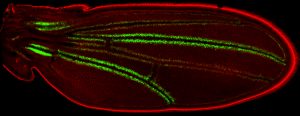
A fruit fly wing, enhanced with red and green fluorescence to study genes involved in development over time.
The following article, highlighting the work of Daniel McKay, PhD appeared in the May 25, 2017 edition of UNC Health Care and UNC School of Medicine’s Vital Signs newsletter and highlights findings published in the June issue of Genes and Development.
Every animal starts as a clump of cells, which over time multiply and mature into many different types of cells, tissues, and organs. This is fundamental biology. Yet, the details of this process remain largely mysterious. Now, scientists at the University of North Carolina at Chapel Hill have begun to unravel an important part of that mystery.
Using the fruit fly Drosophila, a standard lab model for studying animal biology, the researchers discovered a cascade of molecular signals that program gene activity to drive the fly from one stage of maturation to the next, like a baby turning into an adult. Part of this programming, they found, involves alterations to the way DNA is packaged. Those alterations open up certain regions of DNA to allow gene activity and close off other regions to prevent gene activity. The scientists found evidence that these changes to DNA accessibility occur in sequence.
“We’re finally getting at one of the core mechanisms in biology, which determine the timing and sequence of events in normal animal development at the level of our genes,” said Daniel J. McKay, PhD, assistant professor of genetics at the UNC School of Medicine and biology at the UNC College of Arts and Sciences.
Read more at the UNC School of Medicine Newsroom…
